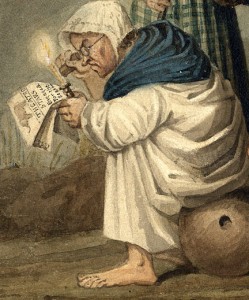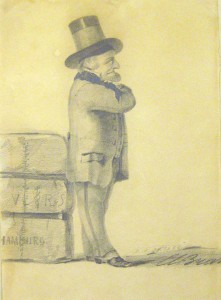Inadvertently, three graduate students were responsible for the creation of the Center for Historic American Visual Culture (CHAVic). Two appeared at AAS asking if we had 18th century prints or lithographs of wedding ceremonies. Another spoke of the struggle to convince her dissertation committee that a history thesis could focus successfully on stereographs. Between the printed word relied on by historians and the fine art prized by art historians lies a world of visual culture often misunderstood or overlooked in the study of America’s past.
 Established in 2005 by the AAS Council, CHAViC’s mission is to provide opportunities for educators to learn about American visual culture and resources, promote the awareness of AAS collections, and stimulate research and intellectual inquiry into American visual materials. The Center received major funding in the spring of 2008 that has enabled AAS to undertake some great initiatives. To see the full panoply of activities from the first teacher workshop held in 2006 to the most recent conference held in October, visit the newest AAS website: http://www.chavic.org.
Established in 2005 by the AAS Council, CHAViC’s mission is to provide opportunities for educators to learn about American visual culture and resources, promote the awareness of AAS collections, and stimulate research and intellectual inquiry into American visual materials. The Center received major funding in the spring of 2008 that has enabled AAS to undertake some great initiatives. To see the full panoply of activities from the first teacher workshop held in 2006 to the most recent conference held in October, visit the newest AAS website: http://www.chavic.org.
For readers of this blog, perhaps the most visible aspect of CHAViC is the enhancement of access to collections previously available only in Antiquarian Hall. Even within the library, many of the collections lacked finding aids and were accessible only on the suggestion of the curator of graphic arts or readers’ services staff. Now that AAS has staff to catalog separately published prints and to produce inventories, the situation has changed dramatically. Searching on the phrase “American Art Union” in the online catalog for example, will bring up over 30 detailed catalog records for the prints in the collection. In due course, images will be linked to these records. There are also records of 385 gift book illustrations! In the past three months over 650 engravings have been carefully described with funds from the National Endowment for the Humanities.
The most recent collection inventory to be created is European Political Prints. There are now fully illustrated inventories of:
 –Photograph Portraits of Native Americans
–Photograph Portraits of Native Americans
-Cased Photographs (Daguerreotypes, Ambrotypes, and Tintypes),
-the David Claypoole Johnston Collection
–Portrait Paintings and Miniatures
–Photographs of Seventeenth- and Eighteenth-Century Structures in Massachusetts taken by Harriette Merrifield Forbes.
Surf the AAS Collections Page for other tantalizing graphic arts collections!
For interpretative projects focusing on AAS collections, check out the online exhibitions portion of the CHAViC website. AAS archives all of its exhibitions.
I hope you will enjoy the new CHAViC website and that we will hear from you if you have questions or want to submit proposals for conferences or fellowships.
Georgia Barnhill, Director
Center for Historic American Visual Culture
Gbarnhill (at) mwa.org

One thought on “You say “Shah-vick,” I say “Chay-vick”: An Introduction to the Center for Historic American Visual Culture”